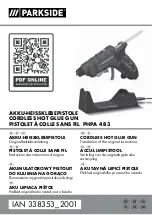
2.
Insert the fuel cell into the tool
i. Pull the latch and open the fuel cell cover (Fig. 6).
ii. Insert the fuel cell into the tool (Fig. 7), making sure
that the stem of the fuel cell lines up correctly with the
hole in the adaptor (Fig. 8).
iii. Close the cover (Fig. 9).
5. LOADING THE TOOL
CAUTION:
When loading nails into tool:
●
Do not depress trigger
●
Do not depress contact arm
●
Keep your face, hands, feet and other body parts,
as well as those of other persons away from the
nose to avoid possible injury during loading.
MODEL: GF33PT-E, GF28WW-E, GCN40T-E
1. Insert nail strip into rear of magazine (Fig. 9).
2. Slide the nail strip forward in the magazine (Fig. 10).
3. Pull the nail feeder (B) back to engage the feeder knob
to the nail strip (Fig. 11).
NOTE Use nail strip of more than 10 nails.
Removing the nails:
1. Pull the feeder knob backward (Fig. 12).
2. Return the feeder knob forward quietly while pushing
the nail feeder (B).
3. Pull out nails from the back of the magazine (Fig.13).
CAUTION
: To prevent unintentional operation, never
touch the trigger or place the top end of the contact arm
on a work bench on floor. Also, never face the nail outlet
toward any part of a person.
NAIL SELECTION: GCN40T-E
To ensure correct fixing when nailing wood to concrete
or thin steel to concrete, please use the fastener length
as indicated below:
Wood to concrete: choose nail for 15-20mm intrusion
depth into the concrete.
Thin steel sheet to concrete: choose nail to secure 12-
20mm intrusion depth into the concrete.
6. USING THE NAILER
CAUTION
●
Squeeze the contact arm when drivng a nail,
otherwise the piston can not return correctly.
●
Using the tool for an extended period may lead to oil
around the exhaust outlet or nose, resulting in
spattering.
●
To ensure that the material to be nailed stays clean,
wipe off any oil that gets on the tool.
CYCLE RATES
These tools are designed to operate up to the following
cycle rates:
Intermittent Operation
– 2 to 3 nails per second
Continuous Operation
– 1000 nails per hour
Exceeding these rates could cause the tool to overheat,
resulting in loss of performance or damage to tool
components. By using the nailer at its recommended
cycle rate, you will be able to drive several thousand
nails in a typical working day.
SAFETY TRIP
These tools are supplied fitted with a sequential safety
trip and are marked with an inverted equilateral triangle
(
▼
).
Do not attempt to use a tool marked in this way if
the safety trip is missing or appears damaged.
The sequential trip requires the operator to hold the tool
against the work with the safety trip depressed before
pulling the trigger. In order to drive additional fasteners,
the trigger must be released and the tool lifted away
from the work, before repeating.
This makes accurate fastener placement easier, for
instance on framing, toe nailing and crating applications.
The sequential trip allows exact fastener location
without the possibility of driving a second fastener on
recoil. The sequential trip tool has a positive safety
advantage because it will not accidentally drive a
fastener if the tool is contacted against the work or
anything else, while the operator is holding the trigger.
FASTENER LOCKOUT (GF33PT / GF28WW)
These tools employ a mechanism to prevent dry firing of
the tool.
When the magazine is not loaded with nails or when the
remaining number of nails becomes less than 10, the
contact arm cannot operate and the tool will not fire.
Wood
Suitable
Intrusion Depth
Thickness
Nail Length
Into Concrete
10mm
30mm
20mm approx.
15mm
35mm
20mm approx.
20mm
40mm
20mm approx.
Summary of Contents for GCN40T
Page 89: ...2002 96 EC 2006 66 EC Bostitch Bostitch GNC40T GF28WW GF33PT Stanley Bostitch StanleyBostitch...
Page 90: ...40 C StanleyBostitch Stanley Bostitch Stanley Bostitch DC 89 686 EEC EEC EN166...
Page 91: ...50 C 120 F 0 32 F 40 C 104 F 0 C 32 F 40 C 104 F 0 40 C 0 C 40 C 20 25 C 15...
Page 94: ...1 2 3 horseplay 1 2 3 4 5 50 C 120 F...
Page 95: ...1500m 5000ft 0 C 30 F 1 1 3 2 3 3 3 2 3 4 1 4 5 OFF 2 i 6 ii 7 8 iii 9 5 1 9 2 10 3 11 10...
Page 101: ...100mm 0 5 50 C 120 F Bostitch Bostitch Bostitch 50 C 120 F Bostitch Bostitch Bostitch...
Page 235: ......
Page 236: ......
Page 237: ......
Page 238: ......














































